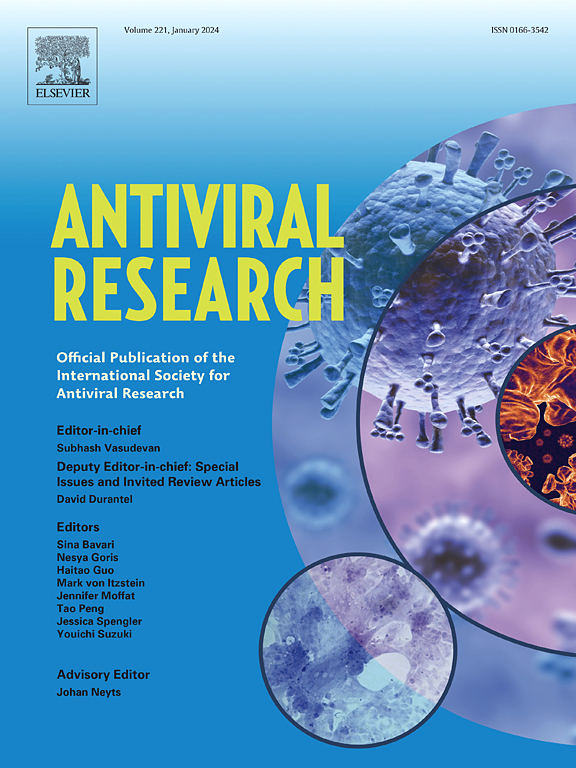The effects of Remdesivir's functional groups on its antiviral potency and resistance against the SARS-CoV-2 polymerase
IF 4.5
2区 医学
Q1 PHARMACOLOGY & PHARMACY
引用次数: 0
Abstract
Remdesivir (RDV, Veklury®) is the first FDA-approved antiviral treatment for COVID-19. It is a nucleotide analogue (NA) carrying a 1′-cyano (1′-CN) group on the ribose and a pseudo-adenine nucleobase whose contributions to the mode of action (MoA) are not clear. Here, we dissect these independent contributions by employing RDV-TP analogues. We show that while the 1′-CN group is directly responsible for transient stalling of the SARS-CoV-2 replication/transcription complex (RTC), the nucleobase plays a role in the strength of this stalling. Conversely, RNA extension assays show that the 1′-CN group plays a role in fidelity and that RDV-TP can be incorporated as a GTP analogue, albeit with lower efficiency. However, a mutagenic effect by the viral polymerase is not ascertained by deep sequencing of viral RNA from cells treated with RDV. We observe that once added to the 3′ end of RNA, RDV-MP is sensitive to excision and its 1′-CN group does not impact its nsp14-mediated removal. A >14-fold RDV-resistant SARS-CoV-2 isolate can be selected carrying two mutations in the nsp12 sequence, S759A and A777S. They confer both RDV-TP discrimination over ATP by nsp12 and stalling during RNA synthesis, leaving more time for excision-repair and potentially dampening RDV efficiency. We conclude that RDV presents a multi-faced MoA. It slows down or stalls overall RNA synthesis but is efficiently repaired from the primer strand, whereas once in the template, read-through inhibition adds to this effect. Its efficient incorporation may corrupt proviral RNA, likely disturbing downstream functions in the virus life cycle.
雷米替韦的官能团对其抗病毒效力和抗 SARS-CoV-2 聚合酶能力的影响。
雷米替韦(RDV,Veklury®)是美国食品及药物管理局批准的第一种治疗 COVID-19 的抗病毒药物。它是一种核苷酸类似物(NA),带有核糖上的 1'-cyano (1'-CN) 基团和假腺嘌呤核碱基,其对作用模式(MoA)的贡献尚不清楚。在这里,我们通过使用 RDV-TP 类似物来剖析这些独立的贡献。我们发现,1'-CN 基团直接导致 SARS-CoV-2 复制/转录复合体(RTC)的瞬时停滞,而核碱基则对这种停滞的强度起作用。相反,RNA 延伸试验表明,1'-CN 基团在保真度方面起作用,RDV-TP 可以作为 GTP 类似物结合,尽管效率较低。然而,对用 RDV 处理过的细胞中的病毒 RNA 进行深度测序并不能确定病毒聚合酶会产生诱变作用。我们观察到,一旦添加到 RNA 的 3' 端,RDV-MP 对切除很敏感,其 1'-CN 基团不会影响 nsp14 介导的切除。在 nsp12 序列中,可以筛选出携带 S759A 和 A777S 两种突变的抗 RDV >14 倍的 SARS-CoV-2 分离物。这两种突变既能使 nsp12 对 RDV-TP 的辨别能力超过 ATP,又能使 RNA 合成过程停滞,从而为切除修复留出更多时间,并有可能降低 RDV 的效率。我们的结论是,RDV 具有多面性。它减缓或阻滞了整个 RNA 合成,但能从引物链中有效修复,而一旦进入模板,通读抑制又会增加这种效果。它的有效加入可能会破坏前病毒 RNA,从而可能干扰病毒生命周期中的下游功能。
本文章由计算机程序翻译,如有差异,请以英文原文为准。
求助全文
约1分钟内获得全文
求助全文
来源期刊

Antiviral research
医学-病毒学
CiteScore
17.10
自引率
3.90%
发文量
157
审稿时长
34 days
期刊介绍:
Antiviral Research is a journal that focuses on various aspects of controlling viral infections in both humans and animals. It is a platform for publishing research reports, short communications, review articles, and commentaries. The journal covers a wide range of topics including antiviral drugs, antibodies, and host-response modifiers. These topics encompass their synthesis, in vitro and in vivo testing, as well as mechanisms of action. Additionally, the journal also publishes studies on the development of new or improved vaccines against viral infections in humans. It delves into assessing the safety of drugs and vaccines, tracking the evolution of drug or vaccine-resistant viruses, and developing effective countermeasures. Another area of interest includes the identification and validation of new drug targets. The journal further explores laboratory animal models of viral diseases, investigates the pathogenesis of viral diseases, and examines the mechanisms by which viruses avoid host immune responses.
 求助内容:
求助内容: 应助结果提醒方式:
应助结果提醒方式:


